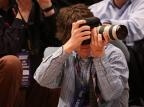Andrew Zaleski>Junior>English>Loyola University Maryland
 Mike Dokas is on deadline. A freshman photographer at Villanova University, Dokas has until midnight to snag a memorable shot from the Villanova-Niagara basketball game and produce a back cover for The Villanovan, his college newspaper. He ended up grabbing a shot of then Villanova sophomore Corey Fisher driving to the basket over a Niagara player falling down. “Niagara Falls,” read the headline—Dokas got the shot and the back cover.
Mike Dokas is on deadline. A freshman photographer at Villanova University, Dokas has until midnight to snag a memorable shot from the Villanova-Niagara basketball game and produce a back cover for The Villanovan, his college newspaper. He ended up grabbing a shot of then Villanova sophomore Corey Fisher driving to the basket over a Niagara player falling down. “Niagara Falls,” read the headline—Dokas got the shot and the back cover.
“It was quite the trial by fire,” he says.
Now a sophomore, Dokas is the man on hand covering Villanova’s men’s basketball team for The Villanovan. As a freshman, he covered Villanova’s 2009 March Madness run, from the Big East Tournament in New York City to their Final Four loss against the Tar Heels of North Carolina. This year, with the Wildcats again poised to make another run deep into March, Dokas stands camera-ready for a repeat run of his own. But the demands on student-photographers tasked with covering their respective teams during the Big Dance can be uniquely challenging.
“[Last year] I didn’t go to class but once or twice a week from the first week of March until the first week in April,” says Dokas. “It was definitely tough missing class for essentially a month.”
Being a student, traveling with and photographing the Wildcats meant that once long nights of shooting were over—which involved not only taking photos, but also selecting shots, doing any necessary touch-up work in Photoshop, and sending those shots to an assigning editor—Dokas, a computer science and history double-major, then had to turn his attention to homework and class projects. And finding a bite to eat, an expense not covered by his newspaper’s budget.
“I did my best to keep up with all my homework and class work, and all of my professors were very understanding,” he says.
But the fast-paced, exciting environment that accompanies sports photography is something that Dokas can’t pass on.
“There is never a chance for a redo in sports photography, and you have no control over your models. Sports photography requires being thrust into an environment and doing everything in your power to capture the essence of that environment, without actually controlling the environment in any way,” he says.
And Dokas knows first-hand the potential dangers of having no control. While covering his first men’s basketball game, Dokas had to duck and cover as 6-foot-8-inch Villanova forward Antonio Peña soared directly over him diving for a loose ball. And in last year’s Final Four game against the Tar Heels, a Villanova player came crashing right into his feet.
“The televised game essentially had my face and the player’s face on screen and that was all,” says Dokas. “I immediately received about a dozen text messages telling me that I was all over the screen.”
But while Dokas has experienced success in the world of sports photography, even having some of his work published in Sports Illustrated magazine, he is hesitant to pursue a career in professional sports photography following Villanova.
“I had the opportunity to cover an NBA game this season, and it definitely stoked the embers of wanting to do it,” Dokas says. “But seasoned photographers I talk to all complain of poor eyesight, long hours and the grueling physical requirements of sitting on courts or hunching over on benches.”
Professional or not, though, photography isn’t something Dokas sees himself giving up.
“I found capturing one specific moment in time to be incredibly rewarding,” he says. “Photography is definitely a passion in my life that won’t soon die.”
To see some of Dokas’ NCAA photos, check out MikeDokas.com.



















